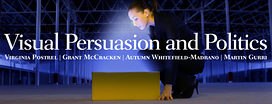Lead Essay
Virginia Postrel argues that it’s a mistake to excise visual appeals from politics. The truth is out there, and yes, we must ultimately rely on empirical work to find it. But to persuade may after all take more than facts and figures. To fight the undeniable glamour of bad public policies, good public policies must respond with a glamour of their own.
Response Essays
In the realm of visual persuasion, Grant McCracken distinguishes luxury from glamour. The former, he finds, is the tool of political power: Luxury is obedient to, and intimately connected with, the state. The state’s messages are its own, more or less. Glamour, though, can come from oppositional groups as well as from the center. Quite often, the state’s attempts at glamour backfire, particularly when it misjudges the public mood, or when its messages reach the wrong audience.
Autumn Whitefield-Madrano looks at the attractiveness of political officeholders. She connects it to scientific research showing that composite faces, made up of the average of many different people, tend to be rated more attractive than most real-world individuals. She suggests that many people seem to look for a similar kind of average when they choose their representatives. And it shows: Politicians tend strongly to be just kind of nice-looking — neither unattractive nor stunningly beautiful. Is this any way to choose a nation’s leaders?
Martin Gurri suggests that the world’s elites have lately lost control over the visual. Anyone can publish images today, and it’s changing the world. Images legitimize, because they help to tell stories, and no social order can sustain itself without stories that justify its existence to the people. But when the people themselves can circulate competing images, they can also circulate some very effective competing stories. It’s not a coincidence, then, that trust in government is at a low ebb around the world today.
Warning: This essay contains images of graphic violence.
Coming Up
Discussion through the end of the month.
Related at Cato
Book Forum: The Power of Glamour: Persuasion, Longing, and Individual Aspiration, with Virginia Postrel, January 29, 2014
Cato Unbound: Brain, Belief, and Politics, with Michael Shermer, Joe Carter, Eliezer Yudkowsky, and Ronald Bailey, September 2011

